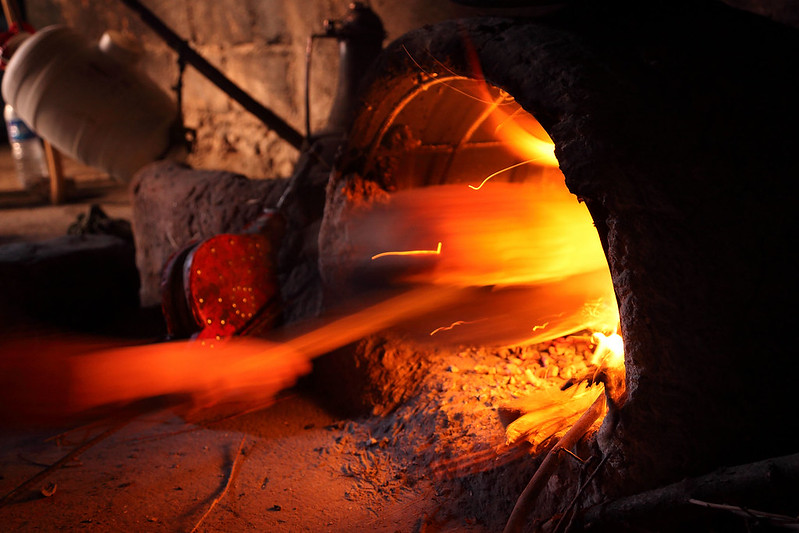
Baking bread for our breakfast, in Gite d'é'tape Tamaloute.
[ <<previous | index | next >> ]
10:08
We have just hit the road out of the M'Goun Valley. I learnt a word of Berber this morning. I said "shukraan" to the owner of the gite where we stayed, and he said that was Arabic, in Berber it is "sahaa".
I got up at 07:30 and went for a walk outside, a short way up the valley to get away from the buildings to take some photos. When I got back, we went into a room in the back of the gite where women were making bread in a wood fired oven. The room was smoky, and one woman was mixing some sort of watery sounding mixture in a plastic drum suspended by ropes on a wooden frame, while another was baking loaves, taking the prepared flat rounds of dough from a series of piles separated by damp cloths. The oven was small, just large enough to bake one of the pizza-sized loaves at a time, and the woman kept feeding in broken sticks to fuel the fire. The bread puffed up hugely with air inside as it cooked, then flattened out again as it cooled. Another woman observing the process saw Jill taking photos on her tablet and became interested in seeing the large, colourful shots. She scrolled through a couple she had taken in the baking room, and then more staff arrived and asked to see more photos. She ended up showing them several dozen photos, going all the way back to our camel ride in the desert, with a crowd of five people looking over her shoulders at them!
 Baking bread for our breakfast, in Gite d'é'tape Tamaloute. |
From there we went to breakfast, which was on the terrace overlooking the green valley and out to the red rocks of the gorge. The sun was just peeking over the rocks on the eastern side of the valley and made the breakfast warm and pleasant in the chill morning air. We had some of the freshly baked bread we'd seen being made, still hot from the oven. I slathered on the fig jam, which was delicious. There were also boiled eggs, roti bread, apricot and strawberry jams, and a thick honey which had a floral smell and tasted a bit like bananas. Everyone seemed chipper and it was a very pleasant breakfast.
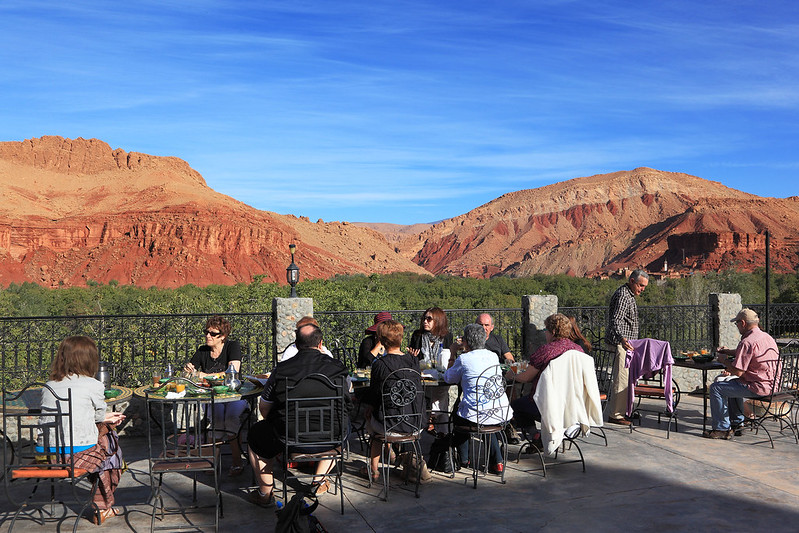 View of M'Goun Valley from our breakfast table. |
12:06
We stopped at a place in Boumalne Dades where they distil roses to make rose water and rose oil. A woman gave us a quick explanation of the distillation process, in a room with ovens for drying rosebuds and a distillation tank. She said that a kilo of roses makes a litre of rose water, but you need 4000 kilos of roses to make one litre of rose oil. There were lots of rose products for sale: soap, shampoo, perfume, oil, hand cream, and so on.
 Drying rose buds to extract rose oil. |
A bit further on we stopped at a lookout spot on the road where it ran along a very narrow ridge, with panoramic views dropping away on either side. On one side was a hill on which a ruined mud brick building resembled a castle. Lahcen said it was an old kasbah.
We are driving across a flat plateau flanked by peaks on both side. To the right is the High Atlas, where we can see a snow capped range, including the peak of M'Goun at 4065 metres, the second highest in the Atlas.
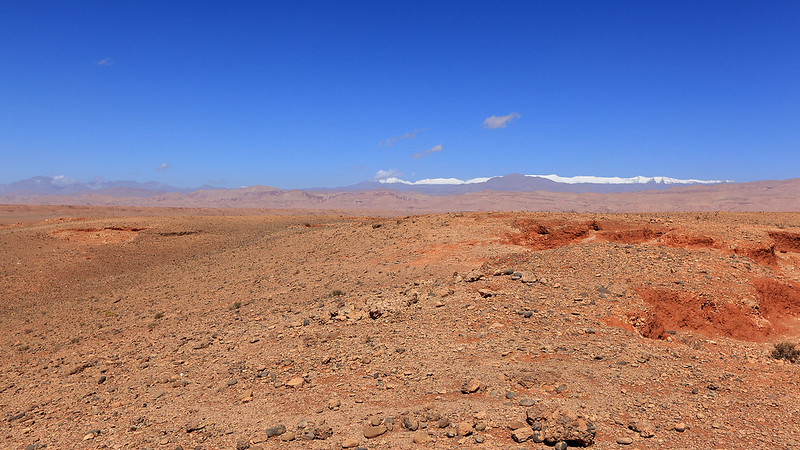 Driving across the plateau, with view of snow on the High Atlas. |
13:27
We are sitting in the Kasbah Ait Ben Moro by the side of the road in the town of Skoura, near the large Kasbah Amridil, which was supposed to be a stop for coffee and to look around, as it is very famous, having featured on the previous 50 dirham bank note. Unfortunately, the access road to Amridil was washed out by the floods in the past few days, so we could only look across the river wash to see it from a distance.
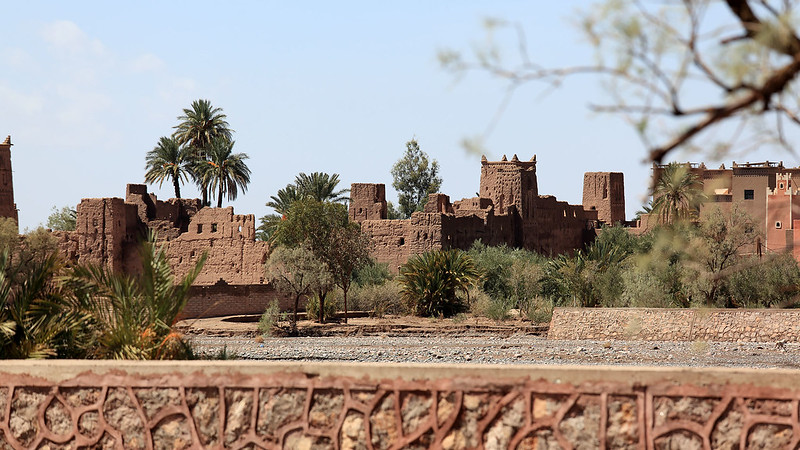 Kasbah Amridil. |
The problem was that as Mohammed turned the bus around on the stony road, one of the stones punctured a rear tyre. So now he has taken the van back to the last town we passed through to get the tyre changed, and we have walked about ten minutes from Amridil to this other kasbah which is being operated as an auberge, so we can sit in the shade and have some drinks while we wait. The view from the rooftop here is pretty good, with the oasis spreading out all around us, green with farms and palm trees, dotted with red mud brick kasbahs and houses, and in the distance the High Atlas mountains, topped with snow.
The road we are on is called the Road of a Thousand Kasbahs. We have passed dozens of them, in various states of repair, from crumbling to being used as hotels.
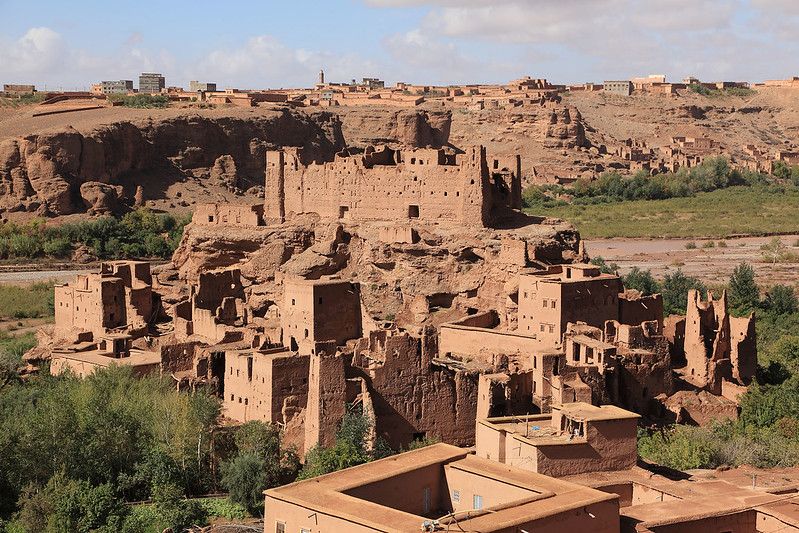 Kasbah on the Road of a Thousand Kasbahs. |
21:21
We have just finished a very nice dinner in our next accommodation.
We got here by passing along the Road of a Thousand Kasbahs, to the movie-making town of Ouazarzete. We stopped there for lunch, and we had two options: a restaurant, or what Lahcen called "street food". Most of us opted for the latter to get an interesting break from the three course lunches with soup and tajines. We had the idea that this would be a marketplace sort of thing with food stalls and we would walk around and buy food from whatever stall appealed to us. But it turned out that we went to a local restaurant with seating spilling out into the street, patronised by locals from the town. The food here was incredibly cheap. M. and I both had the lentils, which came with bread, for just 5 dirhams. I also ordered a plate of chips, which cost another 5, and paid for a communal bottle of water for another 6. The total cost for this lunch for more than two people was 21 dirhams, less than three dollars. The lentils were very good, quite spicy, and the bread was fresh and warm and good too.
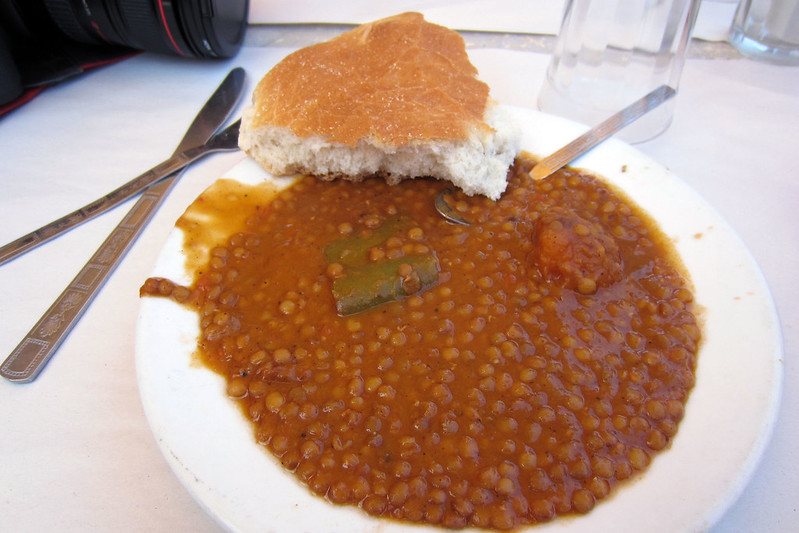 Lentil lunch. |
While eating, several cats came around begging for food. A woman with a baby also came by our table begging. With some consultation with Lahcen, Anna bought her a dish of lentils and bread to eat. The owner of the restaurant wasn't happy about her eating at a table, but let her continue until she was done. When the waiter came around to collect money for the bill, Anna said she was laying for the beggar as well, but the waiter said not to bother, as he would look after the cost of that.
We went back after this meal to collect the restaurant eaters and then took a short guided tour of the Kasbah Taourirt, which was across the road from the restaurant, and also across from a museum of cinema, which looked somewhat tacky from the outside. We had the option of visiting the museum instead of the kasbah if we wanted, but the kasbah was included in our tour and we would have to pay our own admission to the museum. Everyone chose to tour the kasbah.
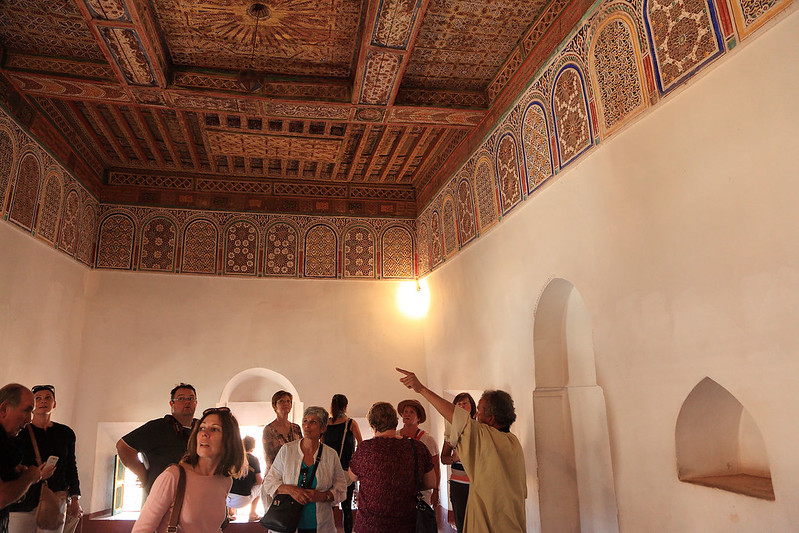 Inside Kasbah Taourirt. |
The guide was an excitable old man in a jellaba who spoke excitedly about the history of the kasbah and the fact that they had filmed the movie Rules of Engagement there, and so Ben Kingsley and Samuel L. Jackson were personal friends of his. He took us through the interior of the kasbah, which was a maze of staircases, rooms, and corridors, all built of mud brick. Some rooms were ornately decorated with wooden ceilings made of painted oleander branches or cedar wood. We saw the Turkish bath room, which had a smallish central room, with two rooms hanging off it, each large enough to hold only one person. The guide said one room was for summer and the other for winter, as they had different heat and ventilation properties because one had a window and the other was deep inside the building. He regaled us with stories of movie making, including one time when three helicopters flew over the kasbah. He said the helicopters ruined some stork nests, killing a whole lot of baby storks, which was an awful thing. At the end of the tour he led us to a sort of gift shop which had dozens of paintings, or abstract Muslim style artwork, and representational art of Berber raiders, kasbahs, and other Hollywood style desert scenes. The art was quite cheap, but I think everyone had been shopped out and nobody bought anything.
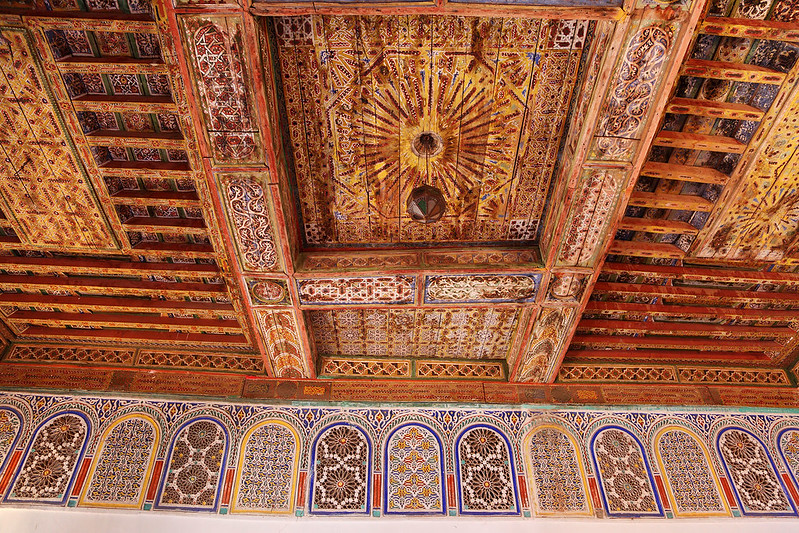 Ceiling decorations in Kasbah Taourirt. |
We left the kasbah, using the toilets on the way out, and rejoined Mohammed and the bus for the short drive to a spice and oil trader in Ouarzazete, called Le Caravane des Épices. Here a man gave us a bit of a talk about all the essential oils and some of the spices they produce here. He rubbed samples of various oils on our hands, wrists, and arms, asking us to try to identify them by smell. They included a blend of argan, amber, and sandalwood; lemon; orange blossom; white musk; ambergris. He crushed some nigella seeds and mixed them with crystallised peppermint, placing the mixture in a tissue, and asked each of us to sniff it deeply with each nostril. It really cleared the sinuses, and several people were a bit shocked at how powerful it was. Then he described some various tea blends they made, with mixtures of teas and herbs, and what each one was good for: soothing, or calming, or upset stomachs, or nausea, or whatever. He also showed us some spice mixes used in Moroccan cuisine, and saffron, which is grown in this region.
They sold all of this stuff, of course, and the prices seemed quite reasonable, especially for the saffron, which was only 60 dirhams for a gram! We bought some for ourselves, and then went back and bought more for our mums. We also got a tube of hand cream made from argan oil (80 dirhams), and a small roll-on of the argan/amber/sandalwood mixture (70 dirhams).
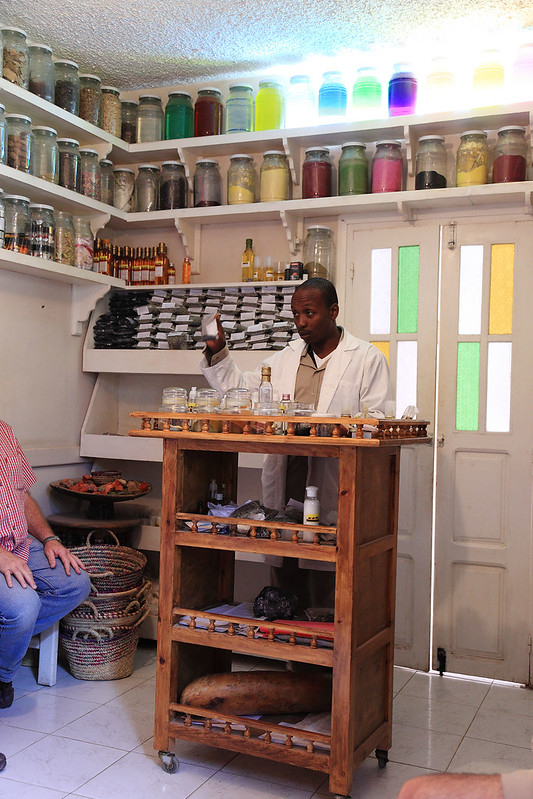 Man demonstrating spices and essential oils at Caravane des Épices. |
From here we drove to our overnight stop at Aït Benhaddou. We stopped at a supermarket to buy some water and bottles of wine, and an ATM for those who needed cash. We bought a 4 litre bottle of water and I split another white wine with Maria.
The next stop was just before Aït Benhaddou, for photos of this picturesque town, before a short final drive to the Hotel La Kasbah. The place is more luxurious than some of the other recent accommodation, and there is a photo of Hillary Clinton in the lobby, from a time when she apparently stayed here, though it's not a five star by any means. The town around us is obviously very touristy, with a lot of little shops with postcards, souvenirs, and supplies like memory cards and so on, though I haven't yet worked out why tourists come here.
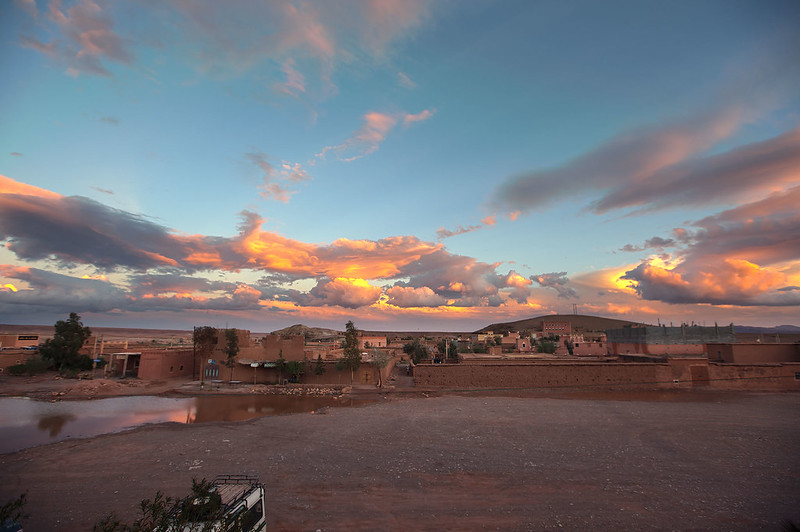 Sunset view from our room at Hotel La Kasbah, Aït Benhaddou. |
We had a hot shower in our room before dinner. The river here is salty, and the water from the taps is salty too, though not as salty as sea water. The taps were all corroded from the salt. Then we went down for dinner at 20:00, picking up people in the lobby who were trying to get onto the WiFi but failing. We took down the bottle of red wine M. had half-bought with Karen, but there was some confusion over whether we could take our own wine into the restaurant. I had assumed, as had some others, that when Lahcen pointed us at a bottle shop next to the supermarket that we could bring our own wine to dinner. But someone else said Lahcen had assumed we were all drinking in our hotel rooms! Anyway, the restaurant didn't want us to bring our own wine, so we might be stuck with a bottle of red wine we can't drink anywhere. When I told Maria we wouldn't be able to have our white wine, someone else said the restaurant only had red, so maybe they'd let us open the white. Someone opened it and it got passed around and nobody complained so it seemed okay.
Dinner was harira, the vegetable soup we've had in a few places, but this one was different again. It was rather spicy, and thicker with rice and small chunks of vegetables, and very delicious. The main was a communal tajine of beef, potatoes, carrots, and zucchini, mild on spice but with a slightly salty sauce, which is unusual as most of the food up to now has been very light on salt and everyone eating with us has been applying salt liberally. It was also delicious. Dessert was simple slices of orange sprinkled with cinnamon, something I definitely have to try at home.
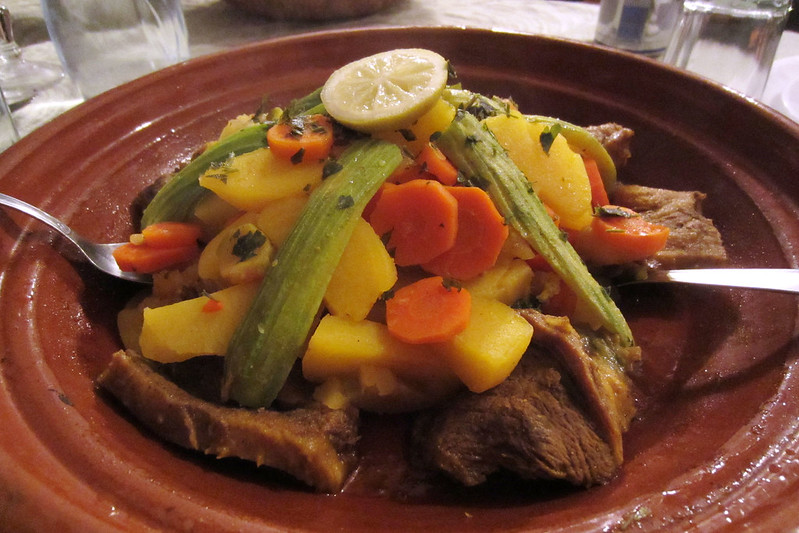 Beef tajine dinner. |
Dinner done, Lahcen explained tomorrow's activities and then we returned to our room for bed.
[ <<previous | index | next >> ]